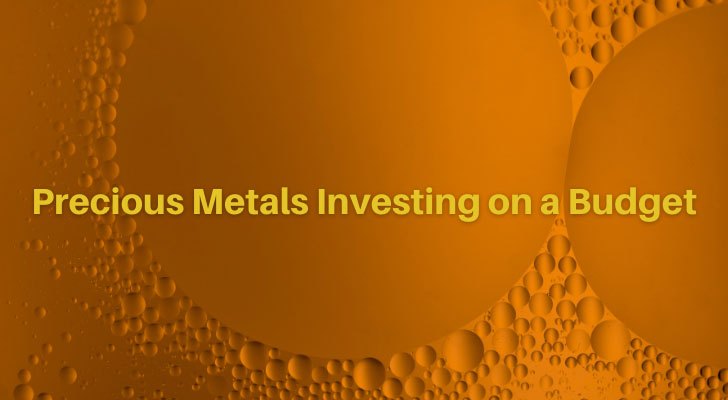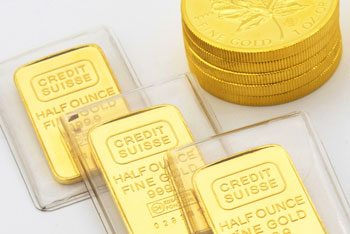Investing in precious metals, like silver and gold, is a popular way to hedge against inflation, thereby protecting portfolios.
In the wake of massive money printing by central banks, interest in gold has spiked in 2020. For example, current advocates for gold include hedge fund founders Paul Singer, Crispin Odey, and David Einhorn. Canadian billionaire and philanthropist Frank Guistra calls gold “the unfortunate, final refuge.”
In the U.S., the recent passage of another stimulus bill sent gold futures higher, in a typical see-saw effect where anticipated currency devaluation drives the yellow metal up.
If you’re interested in this concept of gold and silver as a hedge, or simply want to add them to your portfolio for potential long-term gains, there's good news: you can get started for very little money — probably just what's in your pocket at the moment.
Read on to learn how.

Long-Term Investing vs Short-Term Trading
Since the spread of the coronavirus, there’s been a surge of interest in online trading. Consumers can place short-term "bets" on whether gold or silver (or another asset) will rise or fall in price. Executing a trade is easy, with numerous apps available to choose from.
However, short-term trading is very risky. The majority of traders lose money. Short-term traders need significant knowledge, discipline, and skill in order to succeed.
This article will focus on long-term investing. While gold and silver prices can be quite volatile, they are less so over long periods of time. In fact, people with existing portfolios often use precious metals as a way to hedge their risk.
Why Invest in Precious Metals?
Anyone holding stocks during the 1987, 2001, or 2008 market crashes understands what it feels like to experience rapid losses. And we saw it again in 2020, where the Dow Jones lost one-third of its value over the course of a month. During that same time, despite volatility, gold maintained its price and then grew significantly over the following months.
Allocating a portion of your portfolio into gold and silver may help protect your wealth during a crisis or economic decline. This is because precious metals tend to be counter-cyclical. And more broadly, gold and silver have performed well over the past couple of decades.
How to Invest in Precious Metals
There are many ways to invest in precious metals. Some, like futures, are quite expensive to get started. Others, like CFDs, are fairly simple to use but are not appropriate for investors who want to buy and hold their assets long-term.
The following three forms of precious metal investing will allow you to do so with relatively little money.
#1 Investing via the Stock Market
One way to reap the benefits of investing in precious metals when on a budget is by buying financial shares of exchange-traded funds (ETFs) or the closely-related closed-end funds (CEFs). These assets provide liquidity and can be purchased with small dollar amounts.
For example, the Sprott Physical Gold Trust (PHYS) shares are currently trading at a bit less than $15 a share, and the Sprott Physical Silver Trust (PSLV) is trading at almost $9 a share. That means for the price of a takeout meal or two, you could start investing in precious metals.
Acting as a hybrid between mutual funds and individual stocks, ETFs can be traded on exchanges, making them easy to add to a portfolio. They are very liquid: you can sell them quickly.
Some ETFs, like the Aberdeen Physical Gold Shares ETF (SGOL), trading at a little less than $18, are backed solely by physical assets. As a result, they normally mirror the movements of the underlying asset price.
Other ETFs hold a portfolio of mining and related stocks. These ETFs don't track as close to the underlying asset price. Depending on the circumstances, this can be an advantage or disadvantage.
#2 Stocks
Another option is mining stocks. In this case, you would purchase stocks of one or more companies that mine precious metals.
Note that this is an indirect way of investing. Mining stocks broadly follow the price of precious metals but they don't track as closely as ETFs or physical ownership.
Several companies in this sector offer stocks that can be bought for pennies or a few dollars per share.
This strategy can be riskier than purchasing commodity-based ETFs. But investing in junior mining stocks can also offer high returns. The prices for many of these stocks can shoot up quickly if they make major discoveries. But there is also a chance you could lose everything if a company goes under.
So remember: incorporating these assets into a portfolio should be done with care as they present a higher risk than other methods.
#3 Physical Precious Metals

Services like BullionVault and GoldMoney sell physical gold and silver. You can have the metals delivered to you for storage. But they also offer storage at low fees with a choice of a number of vaults around the world.
You can also buy coins and bars online for home delivery. Consider:
- Junk Silver: Most of the coins minted for circulation in the United States through 1964 contained 90 percent silver. (Half dollars minted from 1965-1970 were 40% silver.) The US minted 90% gold coins through 1933. Other countries have similar old coinage.
- Sovereign Mints: National governments from countries like the United States, Canada, Australia, China, and the UK mint gold and silver coins. The coins produced must meet specific quality and purity standards based on regulations. They are minted for collectors and are valued for more than their precious metal content.
- Private Mints: Private mints create generic "rounds" that are cheaper than government-minted coins. They also produce bars in various weights.
Buying one or more silver coins regularly should be possible for most investors who have limited funds. Realize though that you’ll pay a retail markup for most coins and bars purchased for home delivery.
For this reason, buying shares in gold or silver-backed funds is typically a better way to go. Of course, there is something to be said for holding a coin or bar in your hand. And if this keeps your interest better, it's probably a good way to go.
In all these cases, make sure that you are purchasing from a reputable dealer who is charging a reasonable premium. Some companies charge excessive premiums — especially during times of high demand for precious metals (e.g., during a recession or a pandemic).
Summary
Accumulating precious metal assets (whether physical, via ETFs, or through mining stocks) provides a good way to start investing. It can be done with as little as $10. And you could quickly build-up assets with as little as a dollar a day.
Putting money into precious metals is also a good way to diversify the portfolio of an experienced investor. Having a small percentage of a portfolio allocated to these investment vehicles may provide the protection needed to hedge against an economic crisis and still take advantage of other asset classes when they are thriving.
For those without an existing portfolio, precious metals investing is a good way to get started. Working from precious metals, you can slowly branch out and create your own diversified portfolios, even on a budget.
